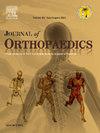股骨颈骨折手术固定后入住康复中心会增加术后静脉血栓栓塞和出血的风险
IF 1.5
Q3 ORTHOPEDICS
引用次数: 0
摘要
的目标是,目的股骨颈骨折(FNF)术后静脉血栓栓塞(VTE)和出血的风险已经确定。尽管并发症发生率较高,但FNF患者出院到康复机构是很常见的。假设FNF手术固定后出院康复与静脉血栓栓塞和出血的风险增加有关。材料,方法使用商业索赔数据库对2019年1月1日至2021年12月31日期间7483例持续FNF并接受手术治疗的患者进行回顾性分析。主要结局为静脉血栓栓塞和术后30天出血。采用logistic回归分析评价静脉血栓栓塞和出血的危险因素。结果静脉血栓栓塞累积发生率为3.77%(95%可信区间(CI) = 3.33 ~ 4.21),出血累积发生率为4.01% (CI = 3.56 ~ 4.46)。出院后康复率为56.7%。多变量分析显示,遗传性高凝诊断(优势比(OR) = 2.86, CI = 1.33-6.16)、出院康复(OR = 2.08, CI = 1.47-2.92)、转院(OR = 1.94, CI = 1.15-3.27)、住院时间(LOS)≥5天(OR = 1.69, CI = 1.15-2.50)增加了术后静脉血栓栓塞的风险。增加出血风险的变量包括康复出院(OR = 2.20, CI = 1.55-3.12)、其他出院(OR = 1.92, CI = 1.12-3.27)和慢性抗凝(OR = 1.58, CI = 1.19-2.10)。对服用血栓预防药物的患者的分析显示,30天出血的VTE累积发生率为3.46% (CI = 2.24-4.68)和4.47% (CI = 3.09-5.85)。结论FNF患者出院康复与术后静脉血栓栓塞和出血风险增加有关。LOS≥5天也与静脉血栓栓塞风险增加相关,表明及时出院的重要性。本文章由计算机程序翻译,如有差异,请以英文原文为准。
Admission to rehab increases risk of postoperative venous thromboembolism and bleeding after operative fixation of femoral neck fractures
Aims & objectives
The risk of postoperative venous thromboembolism (VTE) and bleeding after operative management of femoral neck fractures (FNF) is well established. It is common for FNF patients to be discharged to rehabilitation facilities, despite higher complication rates. It was hypothesized that discharge to rehabilitation after operative fixation of FNF was associated with increased risk of VTE and bleeding.
Materials & methods
Retrospective review of 7483 patients who sustained FNF and underwent operative treatment between 1/1/2019-12/31/2021 was conducted using a commercial claims database. The primary outcome was VTE and bleeding post-discharge within 30 days of surgery. Risk factors for VTE and bleeding were evaluated by logistic regression analysis.
Results
The cumulative incidence was 3.77 % (95 % confidence interval (CI) = 3.33–4.21) for VTE and 4.01 % (CI = 3.56–4.46) for bleeding. There were 56.7 % of patients who were discharged to rehabilitation. Multivariable analysis demonstrated hereditary hypercoagulable diagnosis (odds ratio (OR) = 2.86, CI = 1.33–6.16), discharge to rehabilitation (OR = 2.08, CI = 1.47–2.92), discharge to another location (OR = 1.94, CI = 1.15–3.27), and length of stay (LOS) ≥5 days (OR = 1.69, CI = 1.15–2.50) increased risk for postoperative VTE. Variables that increased risk of bleeding included discharge to rehabilitation (OR = 2.20, CI = 1.55–3.12), discharge to other (OR = 1.92, CI = 1.12–3.27), and chronic anticoagulation (OR = 1.58, CI = 1.19–2.10). Analysis of patients prescribed thromboprophylactic medications demonstrated cumulative incidence of VTE 3.46 % (CI = 2.24–4.68) and 4.47 % (CI = 3.09–5.85) for bleeding at 30 days.
Conclusion
In patients with FNF, discharge to inpatient rehabilitation was associated with increased risk of postoperative VTE and bleeding. LOS ≥5 days was also associated with increased VTE risk, demonstrating the importance of timely hospital discharge.
求助全文
通过发布文献求助,成功后即可免费获取论文全文。
去求助
来源期刊

Journal of orthopaedics
ORTHOPEDICS-
CiteScore
3.50
自引率
6.70%
发文量
202
审稿时长
56 days
期刊介绍:
Journal of Orthopaedics aims to be a leading journal in orthopaedics and contribute towards the improvement of quality of orthopedic health care. The journal publishes original research work and review articles related to different aspects of orthopaedics including Arthroplasty, Arthroscopy, Sports Medicine, Trauma, Spine and Spinal deformities, Pediatric orthopaedics, limb reconstruction procedures, hand surgery, and orthopaedic oncology. It also publishes articles on continuing education, health-related information, case reports and letters to the editor. It is requested to note that the journal has an international readership and all submissions should be aimed at specifying something about the setting in which the work was conducted. Authors must also provide any specific reasons for the research and also provide an elaborate description of the results.
 求助内容:
求助内容: 应助结果提醒方式:
应助结果提醒方式:


